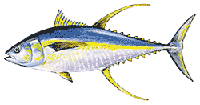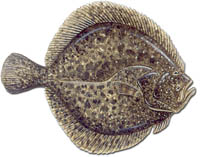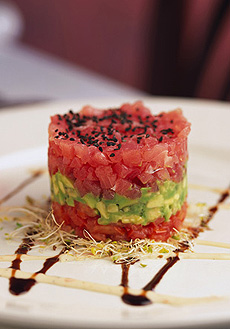Rainbows are usually grown to a size of about a pound or two in earthen ponds or concrete raceways. It takes about 10 to 12 months to grow a rainbow to a harvestable size. In the wild, rainbow trout can grow quite large, reaching 50 pounds in size. While there’s some confusion between rainbow trout and steelhead, they’re essentially the same fish. The difference is their size: farmed and wild steelhead are the same size as salmon, while farmed rainbows rarely exceed 2 pounds.
|
|
A member of the Scombridae family of tuna and mackerel, the Thunnus alalunga is commonly known as albacore tuna. Other names for this species include tombo, longfin tuna, long-finned tunny, albie, albic, Pacific albacore and white tuna, a reference to its light pink flesh. When cooked, albacore has a firm steaky texture, with large, moist flakes. The albacore flesh turns from a reddish pink to an off-white color after cooking. The flavor is a mild, rich taste. It is one of the fatter tunas, with more omega-3s than the rest of the tunas. The albacore can be distinguished from other tuna by its lack of stripes or spots on the lower flanks and belly, and by the thin white trailing edge on the margin of the tail fin. Extremely long, sickle-shaped, black pectoral fins also set albacore apart from other tuna. |
 Photo courtesy of TridentSeafoods.com. |
TUNA-YELLOWFIN, or AHI
|
A truly global resource, yellowfin inhabit warm waters of the Atlantic, Pacific and Indian Oceans. The Mediterranean is the only warm sea where yellowfin are not fished commercially. The Hawaiian name, ahi, refers to both yellowfin and bigeye tuna. Ahi tuna has a texture that is similar to beef, with a much more mild flavor, and is often eaten raw as sashimi or sushi. Yellowfin is one of the largest tunas. It has a mild, meaty flavor. Some say the flavor is similar to swordfish. It is more flavorful than albacore, but leaner than bluefin. When cooked, the meat turns from a bright red to brown or grayish tan. It is firm, yet moist, with large flakes. |
 Photo courtesy of PacSeafood.com. |
|
 Photo courtesy of TridentSeafoods.com. |
Whether it’s caught off Ecuador, Hawaii or Bali, almost all of the true “sashimi-grade” fresh yellowfin and bigeye tuna is sold to Japanese buyers who pay a premium price for 200,000 tons a year, compared to 55,000 tons consumed in the U.S. Yellowfin and bigeye are graded both by fat content and color, which can be an objective exercise, as standards can vary from supplier to supplier, depending both upon the experience of the grader and the condition of the market. Fish with the highest fat content and the brightest red bring a premium price. The amount of myoglobin in a tuna’s muscle determines its color: the more myoglobin, the redder the flesh. The amount of myoglobin is a function of a tuna’s age, physical activity and species. After the flesh of a tuna is exposed to air, an iron ion in the myoglobin molecule will start to oxidize, which turns the meat brown. For that reason, it is important to keep tuna loins and steaks wrapped in plastic.
Read more about the different types of tuna in our Tuna Glossary.
TURBOT
|
To make it more marketable, arrowtooth is usually sold on the West Coast as turbot, although it is not related to the true turbot (Psetta maxima) caught off Europe, which is the most expensive flatfish in the world. Arrowtooth can grow quite large, reaching more than 15 pounds. About 5,000 tons of arrowtooth are landed off the West Coast each year. Greenland turbot, Reinhardtius hippoglossoides, which is caught in both the North Atlantic and North Pacific oceans, is not really a turbot either, but instead is a member of the halibut family (outside of North America, it is called Greenland halibut or black halibut). To avoid marketing confusion with Pacific halibut, the halibut industry successfully lobbied to have the name of this flatfish changed to turbot. |
 |
TURTLE
|
Any of several species of reptiles that live in fresh water, salt water or on land, and have a carapace protecting their bodies. While all types can be eaten, the Sea or Green Turtle is best known. It is also on the endangered species list, and so is very difficult to find, if not illegal to buy in many areas. The Terrapin, considered by many to have the best meat, is a small (7- to 8-inch) turtle that lives fresh or brackish water. Many species of Terrapin are protected. The landlocked tortoises are considered the least desirable of the three types. The meat of the female is more tender than the male’s regardless of the specific species. Many tortoises are on protected or endangered species lists as well, making this difficult to find. But turtle meat can occasionally be found fresh, and sometimes either frozen or canned in specialty markets. |
 |
Continue To Page 13: Seafood Terms Beginning With W
Go To The Alphabet Index Above
Lifestyle Direct, Inc. All rights reserved. Images are the copyright of their respective owners.
![]()
© Copyright 2005-2026 Lifestyle Direct, Inc. All rights reserved. All images are copyrighted to their respective owners.


 Tuna tartare: raw tuna dressed with oil and seasonings. Here, a layer of avocado mimics a tuna avocado role. Photo courtesy of Mortons The Steakhouse.
Tuna tartare: raw tuna dressed with oil and seasonings. Here, a layer of avocado mimics a tuna avocado role. Photo courtesy of Mortons The Steakhouse.
